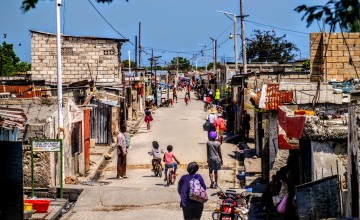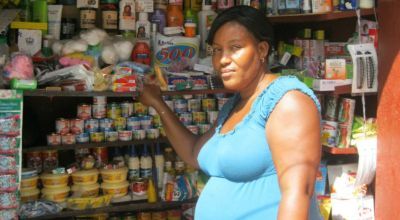
Read our 2024 annual report

Knowledge Hub
Haiti is not a country that many people would normally associate with starvation, but the latest UN forecast reveals a startling situation.
Today, 45% of the population of Haiti faces acute food insecurity, the fifth highest per-capita figure in the world. That's according to the FAO/WFP hunger outlook for the third quarter of 2022. And the number of people on this Caribbean island projected to fall into IPC 4 — the category of hunger one step removed from famine — is 1.3 million. That’s more than Kenya and not far off the figure for Somalia.

Shocking as it may seem, this is a crisis that has been in the making for years. And while internal factors have definitely played a part, much of what's happening to Haitians is outside of their control. Commodity shortages, climate change, and conflict in Ukraine are just the latest in a series of hammer blows to Haitian resilience.
As recently as the 1980s Haiti was largely food self-sufficient, with rice being the main staple crop. Grown widely across many smallholdings, and more intensively in the fertile Artibonite Valley, its prevalence was historically linked to West Africa and the millions of people stolen from that continent during the years of the slave trade.
Today, the price of locally grown rice in Haiti is two or three time higher than imported rice — it makes no sense.
Today however, largely as a result of aggressive American trade policies in the 1990s, over 80 percent of rice, all cooking oil, and nearly half of all the food consumed in Haiti is imported. Tariffs protecting Haitian farmers were slashed and huge amounts of subsidised American rice flooded the market, decimating the agriculture sector and leaving the country at the mercy of international markets. Google it sometime — even Bill Clinton says he regrets what happened.
"Today, the price of locally grown rice in Haiti is two or three time higher than imported rice — it makes no sense," according to Concern's Programme Director Victoria Jean Louis. She says the lack of subsidies and absence of credit facilities for farmers make it almost impossible for them to be commercially successful.
Battered
Global shortages, political instability, rising oil prices, and soaring transport costs have battered the Haitian economy, along with a series of natural disasters — most recently the 2021 earthquake that devastated large parts of the food-producing south west. Inflation is running at nearly 25% and the Haitian gourde has lost 23% of its value against the U.S. dollar in the past year.

One of the few thriving sectors is the illegal drug business. Haiti serves as a major transhipment hub for cocaine and other narcotics coming from South America, mostly destined for the USA. Drug profits largely benefit elite Haitian families and are often used to manipulate politicians and officials and control the gangs that effectively rule many of the communes in Port-au-Prince.
Gang violence in Haiti has soared as the economy has slumped and kidnapping has once again become a popular source of income. Figures for the second quarter of 2022 revealed that 326 people were seized for ransom, with the true number likely to be substantially higher. The latest bout of violence, centered in Cité Soleil, has left scores of people dead, hundreds injured, and thousands displaced. Roads are blocked, leaving entire neighborhoods without access to food, fuel, or clean water. Humanitarian organisations, including Concern, have been severely restricted in their ability to operate, and schools, clinics, and businesses are regularly forced to close.
"The situation is really terrible and vulnerable communities are really suffering," says Victoria Jean-Louis. "The main road from the capital to the food-producing areas in the south is blocked, meaning supplies are slow to get through and very expensive to buy, because they're subject to 'informal taxation'. A lot of the produce is compromised by the time it gets through — it's rotting."
The main road from the capital to the food-producing areas in the south is blocked.
Desperation
All of this has created an increasing desperate situation for Haitian families. If you walk through any street market today, you’ll most likely see people buying galettes: small disc-like cakes, they sell for the equivalent of about 5 cents. Often prescribed for indigestion, especially for pregnant women, they have featured on the Haitian dietary landscape for many years.
Salt, fat, and sometimes sugar help with the consistency and taste, but the main ingredient of these cakes is dirt. Or rather a type of clay, found in the central region of Haiti. It’s strained and mixed with the other ingredients before being formed into cakes and sun-dried, ready for sale at the market. Despite their reputation as an antacid and claims that they contain essential minerals, professional nutritionists remain dubious.

When food is scarce and expensive and money is short, what follows next is almost inevitable. Accurate statistics are hard to come by, but UNICEF last year reported that acute malnutrition in Haitian children was set to double. Weakened by hunger, they will be less able to resist the diarrheal and respiratory diseases that are the leading killers of Haiti's kids.
Also, hunger is undoubtedly a contributing factor to the violence and unrest that's plaguing Haiti. 24 year old Duval Dormeus, who lives in Cité Soleil, says it often drives young people into a life of crime. "My mother always told me that if you are hungry in your belly you can’t do anything else. What else can you do but join an armed group?"
Hunger in Haiti: Solutions
So what are the solutions?
Firstly, it's clear that nothing can happen without increased political stability and a reduction in street violence. And while emergency food supports are a priority to stave off an immediate hunger crisis, they are definitively not the answer to Haiti’s problem. Huge volumes of food aid over the past couple of decades have likely caused more harm than good, creating a reliance that is deeply unhealthy and distorting markets.

According to Concern Country Director, Kwan Li Kladstrup, longer term solutions could include increased support for indigenous food production and making rural life more attractive to young people. "There's great potential for more resilient market-based livelihoods, especially around climate smart agriculture practices, and for more inclusive urban-rural trade linkages to give increased returns on assets and effort."
Follow our work
Follow our journey as we work with communities in 25 of the world's poorest countries to eradicate extreme poverty.

Other ways to help
Corporate support
Is your company interested in working together for a common cause?
Fundraise for Concern
From mountain trekking to marathon running, cake sales to table quizzes, there are lots of ways you can support our work.
Buy a gift
With an extensive range of alternative gifts, we have something to suit everybody.
Leave a gift in your will
Leave the world a better place with a life-changing legacy.
Volunteer with Concern
The lots of ways to get involved with our work as a volunteer
School fundraising
Without the generous support from schools, we wouldn't be able to do the work that we do.




